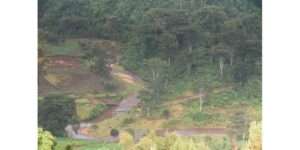From a distance, the Cherangany hills water tower could pass for a dense canopy of indigenous trees with multiple rivers flowing beneath it.
But when a visitor enters the forest, one of Kenya’s five main water towers, the sad reality sinks in.
It is fast fading, with conservationists naming it as one of the most degraded water catchments in the country.
Droves of illegal loggers continue to invade the fragile ecosystem, cutting down indigenous and highly endangered trees with abandon despite the existing moratorium on logging.
The forest, covering over 365,245 hectares (120,841 ha of gazetted forest covers and another 244,404 ha under a buffer zone), sprawls across West Pokot, Trans Nzoia and Elgeyo Marakwet counties.
It is a critical watershed area for the Lake Victoria and Turkana basins and is the source for the Nzoia, Turkwel and Kerio rivers, among others.
But it could be on the verge of total destruction, if the illegal activities are not urgently addressed.
Kenya’s five main water towers
Besides Cherangany, there are four other water towers – Mau forest complex, Mt Kenya, the Aberdares and Mt Elgon. They serve six main drainage basins.
According to Kenya Water Towers Agency’s (KWTA) policy brief, between 1990-2016, 13,003 ha of forest cover was lost in the Cherangany ecosystem, equivalent to an annual loss of 500 ha.
Kapyego Community Forest Association (CFA) chairman John Chesewes told the Nation that the situation is steadily getting worse.
“The highly endangered trees are vanishing daily and the water tower will surely dry up if the concerned agencies do not accelerate the surveillance measures,” he lamented.
“We have on several occasions volunteered information about illegal logging but in return seen little intervention from Kenya Forest Services (KFS).”

JARED NYATAYA (Eldoret).
As members of CFA, they have been combing parts of the forest in an effort to drive out the loggers.
“We are happy when an arrest is made because it deters the perpetrators from engaging in such acts. KFS and other law enforcers should inspect cargo being ferried within this ecosystem because the illegal forest products are usually transported while disguised as farm yields,” he noted.
Cedar, Rosewood trees felled
It is common to find cedar and rosewood trees, among others, haphazardly felled in several spots in the water tower.
The loggers, who reportedly come from as far away as Nairobi and Kisii counties, work in cahoots with unscrupulous locals to cut the trees for timber or charcoal.
And it appears KFS has been outwitted. The loggers ensure their activities go undetected.
The loggers are said to fell the trees using cross-cut saws and axes, avoiding noisy chain saws. Once a tree is felled, it is left on the ground for months to deceive KFS officers that it has been abandoned, only for the loggers to bounce back and split it into posts or timber in record time.
Once out of the forest, the products are loaded onto cover-board trucks, which are then filled with sacks of potatoes and vegetables to disguise them and transported in the dead of night.
Complicit officers
KFS officers and other security agencies have been blamed for being complicit in illegal logging in the water tower.
Mr Bethwel Bitok, another CFA member, said the government needs to increase the number of KFS officers to patrol the forest.
“The forest is expansive and the loggers are very conniving because none has ever been arrested. We suspect they might be working with KFS officers, who usually leak information to them and ensure none is arrested,” claimed Mr Bitok.
Embobut/Embolot Ward Representative Paul Kipyatich said illegal logging is a great threat to the Cherangany hills ecosystem.
“Several harvesting sites have been noted and reported across the ecosystem. Unfortunately, this happens despite the presence of KFS guards manning the forest and various roadblocks in the area. This may be facilitated by insiders within the security organs,” he said.
Banned
Mr Kipyatich wondered how the forest products that were banned find their way to various markets across the country and abroad.
“It is high time locals stood up to end this kind of wanton destruction and protect their forest. The Ministry of Environment and the North Rift conservator must move with speed to investigate officers working in these areas if they are abetting the vice,” he stated.
North Rift acting head of conservancy Anthony Musyoka absolved his officers from the illegal activities but said there are isolated cases of illegal logging in the water tower that have been complicated by individuals growing cedar and rosewood trees on their farms.
“We cannot deny there are pockets of illegal logging within the ecosystem. But individuals have also been illegally cutting down the endangered trees on their private farms on the pretext of using them to build houses, only to be sold and loaded at night,” he said.
He said since the reports first came to their attention, they have heightened patrols across the region and last year impounded over 30 lorries found illegally transporting cedar and rosewood products.
“The illegal loggers usually disguise forest products as either potatoes, vegetables or other crops to avoid detection and usually transport them at night. There is a need for all government agencies and locals to collaborate to end this vice,” he urged.
The loggers, he said, fell the trees and leave them lying on the ground without splitting them only to resurface and make away with them.
“We are sealing all the loopholes and I can promise you, more arrests will be made. We are appealing to the locals to assist us in this fight,” he stated.
KWTA reports that encroachment for agriculture and settlement, uncontrolled exploitation of endangered tree species, political interference, understaffing, limited financial resources and inadequate infrastructure are among the threats to the Cherangany hills water tower.
Credit: Source link